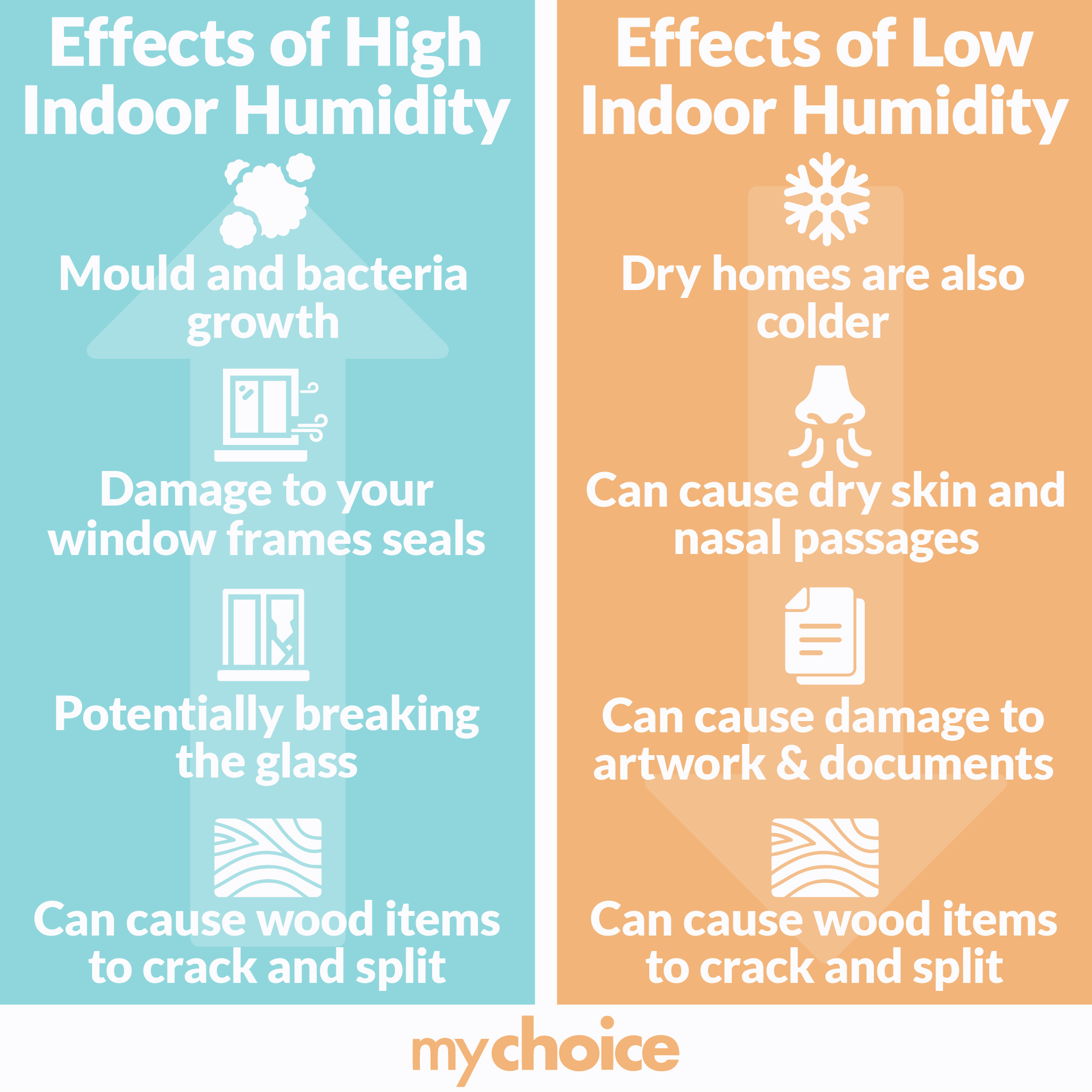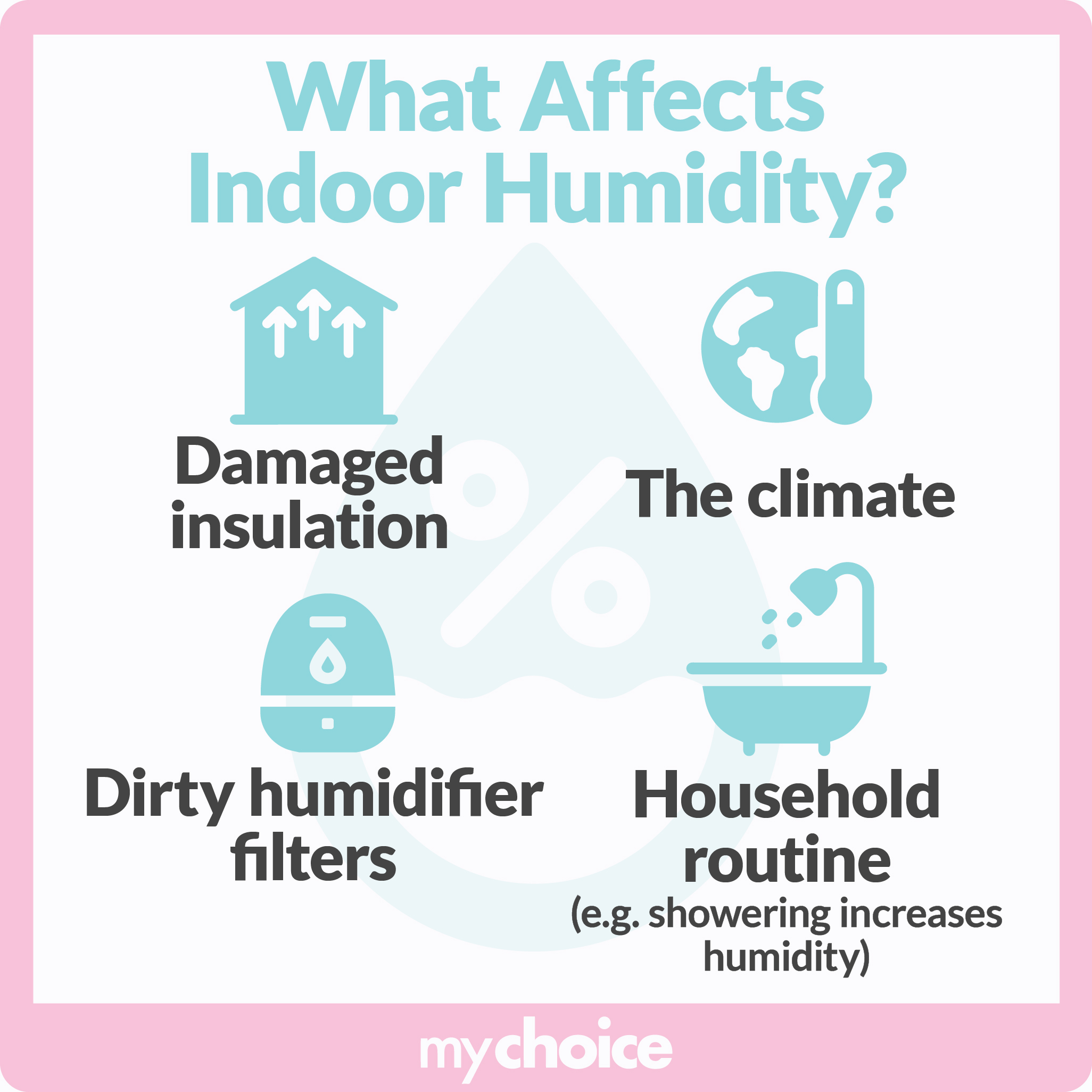The humidity in your house during winter should be around 30% to 40%. Overly high or overly low humidity levels don’t just affect your health but also your home’s well-being. It can even be a risk factor that increases your home insurance rates.
So, how do you get the ideal indoor humidity in winter? Read on to find out.
The Ideal Humidity for a House in Winter
What should the humidity be in a house in winter? The ideal relative humidity range should be between 30 and 40%. This is slightly lower than other seasons when the ideal humidity range is between 30 and 50%. Sticking to the ideal range during winter reduces mould buildup and window condensation.
The 30-40% range is a good general rule of thumb, but multiple factors may need you to raise or lower the range. These factors include the temperatures surrounding your house and the quality of your home’s insulation.
How Does Humidity Affect Your Home?
Humidity affects your home through condensation. High humidity in your house creates water when the dry air from outside hits your windows. Beads of water will start to form and roll down, soaking into your window frame.
If too much water soaks into your window frame, it can even seep into the walls and create mould or wood rot. Home insurance usually covers water damage, but prevention is better than cure. It’s more affordable to prevent condensation in the first place than fix the damage after it happens.
Preventing condensation doesn’t just avoid damage. It may reduce your home insurance rates, especially in the more expensive cities like Calgary and Toronto.
Absolute and Relative Humidity: Know the Difference
There are two common ways to measure humidity: absolute and relative:
- Absolute humidity is calculated in grams to show how much water vapour is in the air. So, absolute humidity doesn’t consider air temperature.
- Relative humidity measures how much water vapour is in the air relative to the air temperature. It’s usually expressed in percentages. We use relative humidity because it considers air temperature.
Negative Effects of Humidity
Low indoor humidity is bad, but so is high indoor humidity. What happens if your indoor humidity isn’t in the sweet spot? Here are the negative effects:
Effects of High Indoor Humidity
Overly humid homes can cause a lot of damage to your home. One of the main problems caused by high humidity is condensation.
Repeated condensation on your windows and frames can damage their seals, reducing energy efficiency. Water running along your windows can also freeze during temperature drops, potentially breaking the glass. Condensation leaking into your walls causes mould and bacteria to grow, leading to allergy irritations and unhealthy living conditions.
High humidity also causes wood furniture and items to crack and split, damaging them. This means any wood structures in your home may be in danger as well.
Effects of Low Indoor Humidity
Unfortunately, too little humidity also has bad effects on your home and well-being. Overly-dry homes cause dry skin and nasal passages. This might increase the frequency of nosebleeds, itchy eyes, and scratchy throats.
People with asthma might also find it harder to breathe in a dry home. Dry homes are also colder because low humidity means your body heat leaves easier.
Low indoor humidity also affects wood because wood needs moisture to prevent cracking. It can also cause damage to artwork and documents.

What Affects Indoor Humidity?
Different homes have different factors that affect indoor humidity. Some of the most common ones include:
- Damaged insulation: Outside air leaking inside your house might change your home’s temperature and humidity levels.
- Household routine: Depending on your household activities, your indoor humidity can be positively or negatively affected. For instance, showering increases humidity, while turning the air conditioner up decreases it.
- The climate: Natural humidity levels change depending on the climate and season. Well-insulated homes should be resistant to this change. But, sometimes, outside air can leak in to impact your indoor humidity.
- Dirty humidifier filters: Dirty filters reduce your humidifier’s effectiveness. You should clean filters at least once a year.

Monitoring Indoor Humidity
The easiest way to test and monitor indoor humidity is with a hygrometer. You can get one from a store cheaply. A hygrometer will measure your home’s relative humidity, so you always know whether your home’s within the ideal humidity range.
You can even get advanced hygrometers that measure humidity in different areas of your home. As a bonus, many hygrometers also measure the room’s temperature so you know if your home is too hot or too cold.
Controlling Humidity at Home
An indoor humidifier is the best way to control humidity in your house. A humidifier can quickly add moisture to your home and keep a comfortable humidity level.
Humidifiers come in all shapes and sizes. Small humidifiers work in a single room, but you can also get whole-house humidifiers that attach to your HVAC.
Some extra ways to increase humidity at home include:
- Air-drying your clothes in rooms you want to humidify: Moisture from your clothes can evaporate and raise indoor humidity.
- Placing houseplants in your house: As long as they’re well-cared for, plants will release moisture into the air.
- Showering with hot water and your bathroom door open: Your bathroom is usually very humid, and letting moisture leave the bathroom can moisturize the rest of the house. Make sure you warn everyone else before taking a bath with the door open.
Does Insurance Cover Damage From Indoor Humidity?
Your standard home insurance probably won’t cover damage from indoor humidity. Most standard home insurance policies only cover damage from sudden and accidental leaks. That said, you should consult your insurance broker or agent to see whether your policy covers indoor humidity damage.
Don’t have home insurance yet? Check our list of Canada’s top home insurers to get started.
Closing Thoughts
The ideal indoor humidity during winter should be 30 to 40%. Higher humidity causes mould and allergies, while lower humidity may cause skin irritation and nosebleeds. You can use indoor humidifiers to keep your humidity in the sweet spot.








